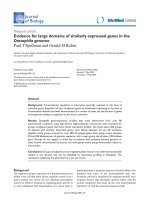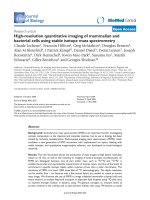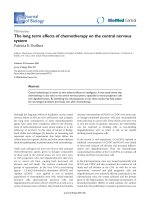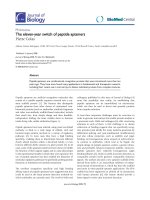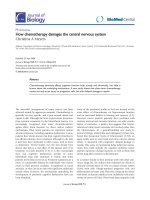Báo cáo sinh học: "Paracentric inversion involving NOR of chromosome 8 in a boar : studies of synaptonemal complexes under a light microscope" pdf
Bạn đang xem bản rút gọn của tài liệu. Xem và tải ngay bản đầy đủ của tài liệu tại đây (1.01 MB, 9 trang )
Original
article
Paracentric
inversion
involving
NOR
of
chromosome
8
in
a
boar :
studies
of
synaptonemal
complexes
under
a
light
microscope
M
&jadnr;wito&jadnr;ski
Academy
of
Agriculture,
Department
of
Genetics
and
Animal
Breeding,
Wolynska,
33,
Pl-60-6
37
Poznan,
Poland
(Received
13
June
1990;
accepted
28
January
1991)
Summary -
In
the
karyotype
of
a
boar
used
in
artificial
insemination
a
paracentric
inversion :
inv(8)(pll,
pl2),
involving
approximately
8%
of
the
chromosome
length,
was
identified.
The
inversion
split
the
nucleolar
organizer
region
(NOR)
into
2
segments.
!n
analysis
of
synaptonemal
complexes
carried
out
under
a
light
microscope
revealed
that
in
a
majority
of
primary
spermatocytes
(87.2%)
heterosynaptic
"straight
pairing"
in
pair
No
8
occurred.
In
the
remaining
cells
delayed
pairing
was
found
in
this
pair.
The
loop
formation
was
not
identified
in
any
of
the
studied
spermatocytes.
In
addition,
no
nonspecific
associations
between
sex
bivalent
and
autosomal
bivalents
were
found.
Consequences
of
the
observed
pairing
behavior
on
fertility
are
discussed.
swine
/ chromosomal
aberration
/ inversion
/ synaptonemal
complex
Résumé -
Inversion
paracentrique
impliquant
l’organisateur
nucléolaire
du
chromo-
some
8
chez
un
verrat;
étude
des
complexes
synaptonémiques
au
microscope
optique.
Dans
le
caryotype
d’un
verrat
utilisé
en
insémination
artificielle
une
inversion
paracen-
trique,
inv(8)(pll,
p12),
impliquant
approximativement
8%
de
la
longueur
du
chromosome,
a
été
identifiée.
L’inversion
partage
la
région
de
l’organisateur
nucléolaire
(NOR)
en
2
segments.
L’analyse
des
complexes
synaptonémiques
réalisée
au
microscope
optique
révèle
que
chez
la
majorité
des
spermatocytes
primaires
(87,2%)
l’hétérosynapsis
de
la
paire
n°8
8
intervient
rapidement.
Dans
le
reste
des
cellules,
l’appariement
pour
cette
paire
est
retardé.
Aucune
formation
de
boucle
d’inversion
n’a
été
observée
chez
les
spermatocytes
étudiés.
En
outre,
aucune
association
non
spécifique
n’a été
trouvée
entre
des
bivalents
sexuels
et
des
bivalents
autosomiques.
Les
conséquences
pour
la
fertilité
du
mode
d’appariement
observé
dans
cette
étude
sont
discutées.
porc
/ aberration
chromosomique
/ inversion
/ complexe
synaptonémique
INTRODUCTION
Extensive
cytogenetic
studies
carried
out
in
pigs
have
revealed
that
the
most
frequently
observed
chromosomal
aberrations
are
reciprocal
translocation
(Popescu
et
al,
1984;
Long,
1988).
Up
till
now
there
has
been
no
report
concerning
any
case
of
inversion
in
this
species.
The
existence
of
an
inversion
in
a
karyotype
can
be
a
cause
of
pairing
disturbances
at
the
pachytene
substage
of
meiotic
prophase
I.
The
accepted
view
is
that
during
the
pairing
stage
loop
formation
is
always
present.
Loop
formation
allows
establishing
homologous
pairing
between
the
inverted
segment
of
one
chromosome
and
the
unchanged
segment
of
the
homologue.
This
can
lead
to
crossing
over
within
the
loop
and,
in
consequence,
to
the
production
of
unbalanced
gametes.
On
the
other
hand,
lack
of
loop
formation
results
in
supression
of
crossing
over
within
the
inverted
segment
due
to
lack
of
homology
and
the
production
of
only
balanced
gametes
(Kaelbling
and
Fechheirner,
1985;
Hale,
1986).
This
means
that
depending
on
pairing
behavior,
variable
effects
on
fertility
in
carriers
of
inversions
can
be
found.
This
paper
presents
the
first
case
of
a
paracentric
inversion
in
swine,
with
special
attention
to
the
analysis
of
synaptonemal
complexes
under
a
light
microscope.
MATERIAL
AND
METHODS
Cytogenetic
studies
were
carried
out
on
a
boar
of
the Polish
Landrace
breed.
The
animal
was
selected
from
among
other
boars used
in
artificial
insemination.
Mitotic
chromosomes
were
studied
by
application
of
conventional
staining
and
banding
techniques :
GTG
(Seabright,
1971)
and
Ag-NOR
(Bloom
and
Goodpas-
ture,
1976).
For
karyotype
analysis
the
international
standard
was
used
(Committee
for
the
Standardized
Karyotype
of
the
Domestic
Pig,
1988).
Synaptonemal
complexes
were
obtained
by
the
use
of
a
spreading
technique
(Counce
and
Meyer,
1973)
for
light
microscope.
The
suspension
of
meiotic
cells
was
spread
on
drops
of
0.2
N
sucrose.
The
air-dried
drops
were
fixed
with
4%
paraformaldehyde
(pH
8.5),
rinsed
in
0.4%
Photo-flo
(Kodak,
pH
8.5)
and
stained
with
50%
AgN0
3
in
a
moist
chamber
(60°C)
for
2
h.
RESULTS
Mitotic
chromosomes
Chromosome
analysis
carried
out
by
application
of
conventional
and
banding
stainings
showed
in
chromosome
No
8
an
additional
chromatin
fragment
within
the
nucleolar
organizer
region
(NOR).
Silver
staining
revealed
in
this
chromosome
a
double
silver
deposit.
Detailed
analysis
of
the
karyotype
indicated that
in
one
chromosome
from
the
No
8
pair
a
paracentric
inversion
had
occurred.
The
breakage
points
were
localized
within
the
nucleolar
organizer
region
and
just
above
the
region.
Approximately
8%
of
the
chromosome
length
was
involved
in
the
inversion.
The
aberration
was
designated
as
inv(8)(pll,
pl2).
Partial
karyotypes
and
a
schematic
drawing showing
the
abberation
are
presented
in
figure
1.
Synaptonemal
complexes
Altogether
47
primary
spermatocytes
were
analyzed
under
a
light
microscope.
All
cells
were
complete
and
each
consisted
of
18
autosomal
bivalents
and
an
XY
bivalent
(fig
2).
The
sex
bivalent
showed
variable
behavior
and
4
morphological
types
were
distinguished
(table
I).
Types
1,
2
and
3
were
classified
according
to
the
behavior
of
the
free
ends
of
both
sex
chromosomes
in
the
following
way :
1),
no
contact
between
them;
2),
the
free
ends
are
associated
end-to-end;
and
3),
the
free
ends
are
synapsed.
Type
4
occurred
when
the
axes
of
the
sex
bivalent
were
tangled.
Most
of
the
studied
spermatocytes
(57.5%)
demonstrated
additional
association
or
pairing
between
free
ends
of
the
X
and
Y
chromosomes.
analysis
of
autosomal
bivalents
showed
that
in
the
majority
of spermatocytes
(40
cells)
all
were
fully
paired.
In
the
case
of
7
spermatocytes
one
autosomal
bivalent
was
partly
unpaired
(figs
3,
4).
Measurements
of
the
length
of
all
the
autosomal
bivalents
within
such
cells
showed
that
the
bivalent
with
an
unpaired
segment
had
the
fourth
or
fifth
longest
length.
This
position
corresponds
to
the
length
of
chromosome
8
obtained
in
mitotic
chromosomes
(Fries,
1982;
Vth
Committee
for
the
Standardized
Iiaryotype
of
the
Domestic
Pig,
1988).
Delayed
pairing
in
pair
No
8
occurred
in
spermatocytes
which
had
a
sex
bivalent
of
morphological
type
1
or
2
(table
I).
No
nonspecific
associations
between
the
sex
bivalent
and
autosomal
bivalents
were
found.
Data
concerning
fertility
of
the
inversion-carrier
was
not
available.
DISCUSSION
The
paracentric
inversion
described
in
this
paper
is
most
likely
the
first
case
of
such
rearrangement
found
in
pigs.
The
inverted
chromosomal
fragment
was
rather
small
and
involved
M
8%
of
the
length
of
chromosome
8
alone.
It
is
an
open
question
whether
the
length
of
the
inverted
fragment
may
be
responsible
for
this
pairing
behavior.
In
the
case
of
inversion
carriers
this
behavior
is
subdivided
into
3
stages :
asynapsis,
loop
formation
and
heterosynaptic
&dquo;straight
pairing&dquo;.
The
classical
sequence
of
events
during
late
zygotene
and
pachytene
starts
with
asynapsis
and
is
followed
by
loop
formation
and,
in
late
pachytene,
the
size
of
the
loop
decreases
and
finally
heterosynaptic
&dquo;straight
pairing&dquo;
is
established.
In
fact,
such
a
regular
sequence
of
events
was
found
to
be
not
very
common.
In
some
cases
such
a
sequence
was
observed
(Davisson
et
al,
1981;
Poorman
et
al,
1981;
Moses
et
al,
1982;
Guichaoua
et
al,
1985;
Gabriel-Robez
et
al,
1986;
Batanian
and
Hulten,
1987)
but
in
others
asynapsis
was
followed
directly
by
heterosynapsis
(Greenbaum
and
Reed,
1984;
Kaelbling
and
Fechheimer,
1985;
Hale,
1986;
Hale
and
Greenbaum,
1988;
Gabriel-Rodez
et
al,
1988;
and
the
present
case).
There
is
no
clear
explanation
as
to
what
factors
are
responsible
for
the
pairing
behavior
of
bivalents
which
are
heterozygous
for
inversion.
In
a
review
of
6
cases
of
pericentric
inversions
in
humans,
de
Perdigo
et
al
(1989)
indicated
that
loop
formation
occurred
only
in
those
cases
where
both
breakage
points
were
located
within
the
G-light
bands.
In
other
cases,
only
heterosynapsis
occurred.
This
observation
was
in
agreement
with
the
hypothesis
formulated
by
Ashley
(1988),
who
suggested
that
pairing
behavior
of
chromosomal
aberrations
depended
upon
the
breakpoint
positions.
In
the
present
case
the
breaks
occurred
in
the
light
and
dark
G-bands;
however,
it
is
also
important
to
notice
that
a
fairly
small
chromosomal
fragment
was
inverted.
In
such
a
case,
due
to
the
shortness
of the
inverted
fragment,
establishment
of
loop
formation
may
be
impossible
for
physical
reasons.
In
the
present
study,
behavior
of
the
sex
bivalent
was
used
as
an
indicator
of
the
sequence
of
pairing
events
during
pachytene.
Additional
association
or
pairing
between
the
free
ends
of
the
sex
chromosomes
has
already
been
described
in
pigs
(Switonski
and
Gustavsson,
1986).
The
same
phenomenon
has
also
been
observed
in
human
spermatocytes
(Chandley
et
al,
1984;
Solari,
1988).
The
latter
author
has
shown
that
the
frequency
of
such
a
configuration
increased
during
meiotic
pairing
from
the
late
zygotene/early
pachytene
to
later
substages
of
pachytene.
It
seems
reasonable
to
assume
that
due
to
the
so-called
correction
phase
of
late
pachytene
(von
Wettstein
et
al,
1984)
association
between
free
ends
(type
2)
is
followed
by
pairing
between
free
ends
(type
3).
The
tangled
structure
of
the
sex
bivalent
(type
4)
is
generally
classified
as
the
last
substage
of
pachytene
and
in
Solari’s
(1988)
classification
is
called
a
&dquo;net-like
filamentous
arrangement&dquo;.
Taking
into
consideration
the
above-mentioned
remarks,
it
can
be
concluded
that
the
observed
delayed synapsis
in
pair
No
8
occurred
during
the
first
part
of
pachytene
(types
1
and
2).
On
the
other
hand,
the
low
frequency
of
spermatocytes
with
delayed
pairing
seemed
to
be
a
result
of
the
very
short
length
of
the
inverted
fragment.
This
probably
caused
a
marked
quickening
of
the
process
of heterosynaptic
&dquo;straight
pairing&dquo; .
Depending
on
the
pairing
behavior,
2
main
types
of
meiotic
segregation
may
be
expected.
Loop
formation
establishes,
by
complete
homologous
pairing,
conditions
for
crossing
over
within
the
loop.
If
this
happens
then
dicentric
or
acentric
chromosome
fragments
will
arise.
In
such
a
case
the
fertility
of
the
inversion
carrier
will
be
reduced
due
to
the
production
of
unbalanced
gametes.
Lack
of
loop
formation
and
subsequent
heterologous
pairing
prohibits
crossing
over
events
within
the
inverted
fragment.
This
causes
regular
chromosome
segregation
and
the
fertility
of
the
carrier
is
not
affected.
The
latter
situation
probably
occurred
in
the
present
case.
Unfortunately,
data
concerning
the
fertility
of
the
carrier-boar
was
not
available.
It
is
known
that
unspecific
association
between
the
sex
bivalent
and
autoso-
mal
configuration,
particularly
consisting
of
rearranged
chromosomes
(trivalents,
quadrivalents,
etc),
can
cause
activation
of
an
X
chromosome
in
primary
spermato-
cytes,
which
is
responsible
for
the
arrest
of spermatogenesis
(Lifschytz
and
Lindsley,
1972).
In
the
present
case,
as
well
as
in
other
cases
of
inversions
described
by
other
authors,
no
associations
between
the
sex
bivalent
and
the
autosomal
bivalent
car-
rying
an
inversion
were
found.
Besides
meiotic
disturbances
in
carriers
of
chromosome
inversions
the
effect
of
position
should
also
be
taken
into
consideration.
The
new
gene
neighbourhood
at
breakage/rejoining
points
can
also
cause
activation
or
inhibition
of
gene
expression.
ACKNOWLEDGMENT
I
thank
Mrs
A
Pietrzak
for
excellent
laboratory
assistance.
REFERENCES
Ashley
T
(1988)
G-band
position
effects
on
meiotic
synapsis
and
crossing
over.
Genetics
118,
307-317
Batanian
J,
Hulten
MA
(1987)
Electron
microscopic
investigations
of synaptonemal
complexes
in
an
infertile
human
male
carrier
of
a
pericentric
inversion
inv(1)(p32,
q42).
Regular
loop
formation
but
defective
synapsis
including
a
possible
interchro-
mosomal
effect. Hum
Genet
76,
81-89
Bloom
SE,
Goodpasture
C
(1976)
A
improved
technique
for
selective
staining
of
nucleolar
organizer
regions
in
human
chromosomes. Hum
Genet
34,
199-206
Chandley
AC,
Goetz
P,
Hargreave
TB,
Joseph
AM,
Speed
RN
(1984).
On
the
nature
and
extent
of XY
pairing
at
meiotic
prophase
in
man.
Cytogenet
Cell
Genet
38,
241-247
Committee
for
the
Standardized
Karyotype
of
the
Domestic
Pig
(co-ordinator :
Gustavsson
1)
(1988)
Standard
karyotype
of
the
domestic
pig.
Hereditas
109,
151-
157
Counce
SJ,
Meyer
GF
(1973)
Differentiation
of
the
synaptonemal
complex
and
their
kinetochore
in
Locusta
spermatocytes
studied
by
whole
mount
electron
microscope.
Chromosoma
44,
231-253
Davisson
MT,
Poorman
PA,
Roderick
TH,
Moses
MJ
(1981)
A
pericentric
inversion
in
the
mouse.
Cytogenet
Cell
Genet
30,
70-76
Fries
HR
(1982)
Naturliche
und
induzierte
Markerchromosomen
beim
Schwein
und
ihre
Verwendung
fur
die
Genkartierung.
Dissertation
ETH
Zurich,
7160
Gabriel-Robez
0,
Ratomponirina
C,
Rumpler
Y,
Le
Marec
B,
Luciani
JM,
Guichaoua
MR
(1986)
Synapsis
and
synaptic
adjustment
in
an
infertile
human
male
heterozygous
for
a
pericentric
inversion
in
chromosome
1. Hum
Genet
72,
148-152
Gabriel-Robez
0,
Ratomponirina
C,
Croquette
M,
Coutuerier
J,
Rumpler
Y
(1988)
Synaptonemal
complexes
in
a
subfertile
man
with
a
pericentric
inversion
in
chromosome
21.
Heterosynapsis
without
previous
homosynapsis.
Cytogenet
Cell
Gene
48,
84-87
Greenbaum
IF,
Reed
MJ
(1984)
Evidence
for
heterosynaptic
pairing
of
the
inverted
segment
in
pericentric
inversion
heterozygotes
of
the
deer
mouse
(Peromyscus
maniculatus).
Cytogenet
Cell
Genet
38,
106-111
Guichaoua
MR,
Delafontaine
D,
Taurelle
R,
Taillemite
JL,
Morazzani
MR,
Luciani
JIVI
(1985)
Loop
formation
and
synaptic
adjustment
in
a
human
male
heterozygous
for
two
pericentric
inversions.
Chrorrcosoma
93,
313-320
Hale
DW
(1986)
Heterosynapsis
and
suppression
of
chiasmata
within
heterozygous
pericentric
inversions
of
the
Sitka
deer
mouse.
Chrorraosoma
94,
425-432
Hale
DW,
Greenbaum
IF
(1988)
Synapsis
of
a
chromosomal
pair
heterozygous
for
a
pericentric
inversion
and
the
presence
of
a
heterochromatic
short
arm.
Cytogenet
Cell
Genet
48,
55-57
Kaelbling
M,
Fechheimer
NS
(1985)
Synaptonemal
complex
analysis
of
a
pericentric
inversion
in
chromosome
2
of
domestic
fowl,
Gallns
domesticus.
Cytogenet
Cell
Genet
39,
82-86
Lifschytz
E,
Lindsey
D
(1972)
The
role
of
X-inactivation
during
spermatogenesis.
Proc
Natl
Acad
Sci
USA
69,
182-186
Long
SE
(1988)
Segregation
patterns
and
fertility
of
domestic
mammals
with
chro-
mosome
translocations.
In :
The
Cytogenetics
of
Mammalian
Autosomal
Rearrange-
ments.
(Art
D,
ed)
AR
Liss
Inc,
New
York,
383-396
Moses
MJ,
Poorman
PA,
Roderick
TH,
Davisson
MT
(1982)
Synaptonemal
complex
analysis
of
mouse
chromosomal
rearrangement.
IV.
Synapsis
and
synaptic
adjust-
ment
in
two
paracentric
inversions.
Chromosoma
84, 457-474
Perdigo
A
de,
Gabriel-Robez
0,
Rumpler
Y
(1989)
Correlation
between
chromoso-
mal
breakpoint
positions
and
synaptic
behaviour
in
human
males
heterozygous
for
a
pericentric
inversion.
Hum
Genet
83,
274-276
Poorman
PA,
Moses
MJ,
Davisson
MT,
Roderick
TH
(1981)
Synaptonemal
complex
analysis
of
mouse
chromosomal
rearrangements.
III.
Cytogenetic
observations
on
two
paracentric
inversions.
Chromosoma
83,
419-429
Popescu
CP,
Bonneau
M,
Tixier
M,
Bahri
I,
Boscher
J
(1984)
Reciprocal
translo-
cations
in
pigs.
Their
detection
and
consequences
on
animal
performances
and
economic
losses.
J
Hered
75,
448-452
Seabright
M
(1971)
A
rapid
banding
technique
for
human
chromosomes.
Lancet
2,
971-972
Solari
AJ
(1988)
Synaptic
behaviour
and
recombination
nodules
in
the
human
XY
pair.
Genctica
77,
149-158
Switonski
M,
Gustavsson
I
(1986)
The
synaptonemal
complex
of
the
X-Y
bivalent
in
pigs
and
cattle
studied
by
electron
microscope.
7th
Eur
Coll
Cytogenetics
of
Domestic
Animals,
Warsaw,
abstr,
40-41
Wettstein
D
von,
Rasmussen
SW,
Holm
PB
(1984)
The
synaptonemal
complex
in
genetic
segregation.
Ann
Rev
Genet
18,
331-413

